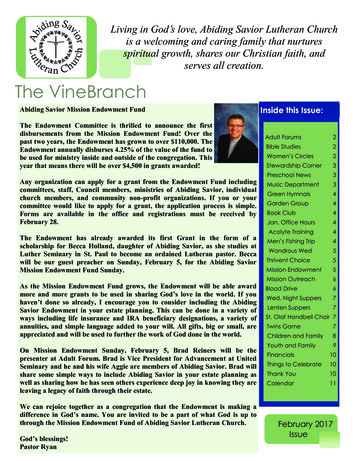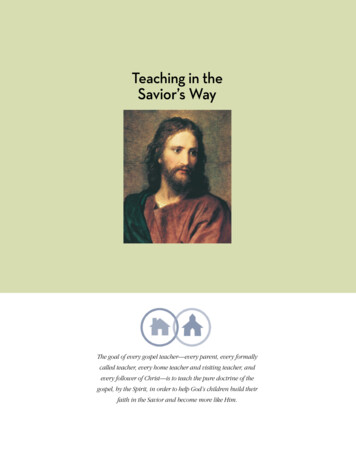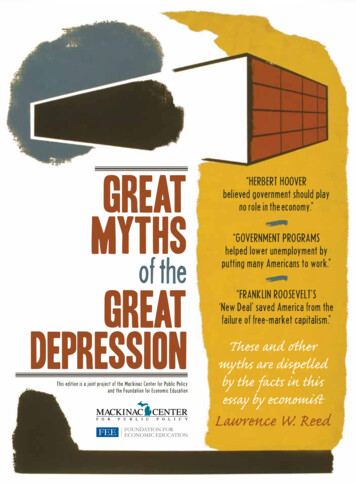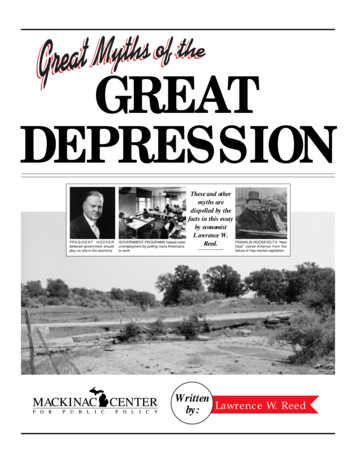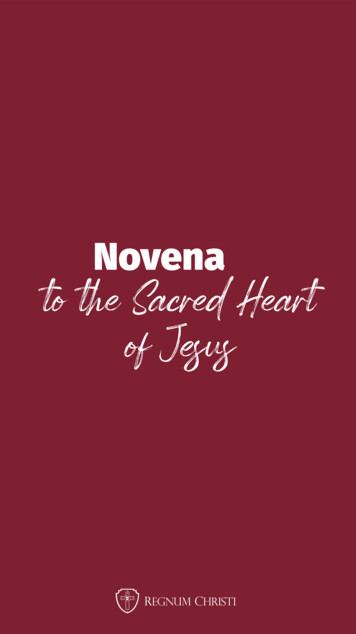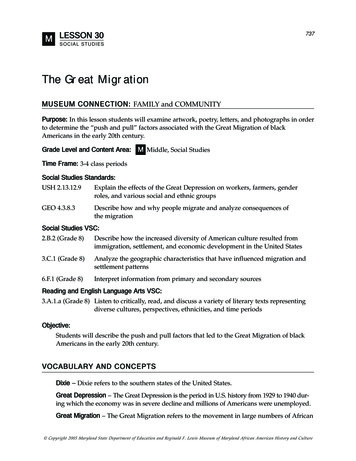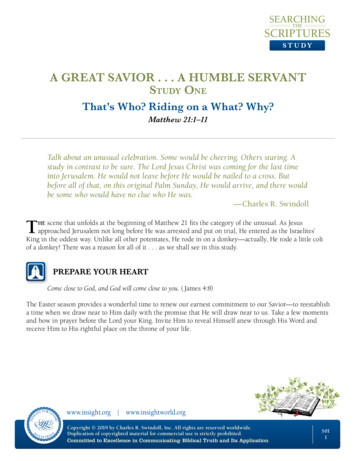
Transcription
ST U DYA GREAT SAVIOR . . . A HUMBLE SERVANTStudy OneThat's Who? Riding on a What? Why?Matthew 21:1–11Talk about an unusual celebration. Some would be cheering. Others staring. Astudy in contrast to be sure. The Lord Jesus Christ was coming for the last timeinto Jerusalem. He would not leave before He would be nailed to a cross. Butbefore all of that, on this original Palm Sunday, He would arrive, and there wouldbe some who would have no clue who He was.—Charles R. SwindollTscene that unfolds at the beginning of Matthew 21 fits the category of the unusual. As Jesusapproached Jerusalem not long before He was arrested and put on trial, He entered as the Israelites’King in the oddest way. Unlike all other potentates, He rode in on a donkey—actually, He rode a little coltof a donkey! There was a reason for all of it . . . as we shall see in this study.hePREPARE YOUR HEARTCome close to God, and God will come close to you. ( James 4:8)The Easter season provides a wonderful time to renew our earnest commitment to our Savior—to reestablisha time when we draw near to Him daily with the promise that He will draw near to us. Take a few momentsand bow in prayer before the Lord your King. Invite Him to reveal Himself anew through His Word andreceive Him to His rightful place on the throne of your life.www.insight.org www.insightworld.orgCopyright 2019 by Charles R. Swindoll, Inc. All rights are reserved worldwide.Duplication of copyrighted material for commercial use is strictly prohibited.Committed to Excellence in Communicating Biblical Truth and Its ApplicationS011
A GREAT SAVIOR . . . A HUMBLE SERVANTStudy OneThat’s Who? Riding on a What? Why?ST U DYMatthew 21:1–11YOUR TURN IN THE SCRIPTURESRead Matthew 21:1–11 to get an overview of the passage. While you read, pay attention to things in thepassage that seem familiar to you, and make notes about details that you haven’t noticed in prior readings.Record your thoughts in the space provided.Observation: Preparing for His Arrival—Matthew 21:1–3According to the Searching the Scriptures method of Bible study, we observe the text by looking for words orsections that are compared, contrasted, emphasized, repeated, or related. We look for central ideas, such asthe overall principle Paul stated in Matthew 21:1–11.Where Was Jesus?Read Matthew 21:1–3 and observe important details about the setting of this scene.Who was Jesus traveling with according to Matthew?What geographical clues emerge that help you place Jesus’ whereabouts?Copyright 2019 by Charles R. Swindoll, Inc. All rights are reserved worldwide.Duplication of copyrighted material for commercial use is strictly prohibited.Committed to Excellence in Communicating Biblical Truth and Its ApplicationS012
A GREAT SAVIOR . . . A HUMBLE SERVANTStudy OneThat’s Who? Riding on a What? Why?ST U DYMatthew 21:1–11Look closely at the map or check in the map section of your study Bible and locate a map titled “Ministry ofJesus” or something similar. Find Jerusalem and see how many of the cities and surrounding landmarks arementioned in Matthew 21:1. What do you see? Make notes about your discoveries.This would be a good opportunity for you to consult a Bible dictionary and look up the city of Bethphage andthe Mount of Olives. Study what is written about these historical sites. Write down relevant observations.What Did Jesus Do?Trace the sequence of events in Matthew 21:2–3, and list some observations about what Jesus directed thedisciples to do.Jesus seemed quite determined to make certain all went according to plan for this significant occasion. Howwould you summarize the instructions He gave to His disciples (Matthew 21:2–3)?Copyright 2019 by Charles R. Swindoll, Inc. All rights are reserved worldwide.Duplication of copyrighted material for commercial use is strictly prohibited.Committed to Excellence in Communicating Biblical Truth and Its ApplicationS013
A GREAT SAVIOR . . . A HUMBLE SERVANTStudy OneThat’s Who? Riding on a What? Why?ST U DYMatthew 21:1–11As enigmatic as Jesus’ entry into Jerusalem was, even more stirring was the response of the people.What wonder there is in considering the significant meaning in the exuberant praise offered to thisdonkey-riding King!Interpretation: Fulfilling the Prophet’s PredictionAt times, the meaning of a passage is made apparent by the passage itself—in other words, either throughdialogue or the author’s clear interpretation. That’s the case especially when the gospel writers referenced anOld Testament passage to explain their meaning.Matthew, passionate for his Jewish readers to embrace Jesus as their Messiah King, invoked the reveredwords of Isaiah to build his case.“Tell the people of Israel,‘Look, your Savior is coming.See, he brings his reward with him as he comes.’ ” (Isaiah 62:11)To understand why Matthew included this story of Jesus riding into Jerusalem on a donkey colt, we mustlook to Isaiah:1. To demonstrate that prophecy is fulfilled in this event2. To identify Jesus as the promised King of the people of Jerusalem3. To make plain that Jesus embodies genuine humilityWhat impact do you think Matthew’s use of Isaiah’s prophecy had on his Jewish audience? Why?Still, Isaiah was only one among many Old Testament writers who envisioned Matthew’s scene when theypenned their words.Copyright 2019 by Charles R. Swindoll, Inc. All rights are reserved worldwide.Duplication of copyrighted material for commercial use is strictly prohibited.Committed to Excellence in Communicating Biblical Truth and Its ApplicationS014
A GREAT SAVIOR . . . A HUMBLE SERVANTStudy OneThat’s Who? Riding on a What? Why?ST U DYMatthew 21:1–11Correlation: Responding to the KingCorrelation compares different passages of Scripture to help interpret the passage in view. In Matthew’sdescription of the crowd’s response to Jesus, he invoked another Old Testament passage. This time, one ofthe psalms:Jesus was in the center of the procession, and the people all around him were shouting,“Praise God for the Son of David!Blessings on the one who comes in the name of the Lord!Praise God in highest heaven!” (Matthew 21:9)In this case, Matthew lifted from the Psalms a worship expression well-known to his Jewish audience tofurther strengthen his appeal to Jesus as their Messiah King.Please, Lord, please save us.Please, Lord, please give us success.Bless the one who comes in the name of the Lord.We bless you from the house of the Lord. (Psalm 118:25–26)Application: What about You and Me?Application moves us from maintaining a mere intellectual understanding of a passage to allowing truth topenetrate the heart. Take some time now to reflect on where you would be in this story—peasant or priest,scoffer or seeker, wonderer or worshiper. Think about each of the many individuals who encountered Jesusthat day. Who heard the throng of witnesses shouting “Hosanna!”?Would you find yourself among one of Jesus’ close followers? A disciple? If so, how does your life todayreflect your devotion to Him, not just as Savior but as Lord of your life?Copyright 2019 by Charles R. Swindoll, Inc. All rights are reserved worldwide.Duplication of copyrighted material for commercial use is strictly prohibited.Committed to Excellence in Communicating Biblical Truth and Its ApplicationS015
A GREAT SAVIOR . . . A HUMBLE SERVANTStudy OneThat’s Who? Riding on a What? Why?ST U DYMatthew 21:1–11Would you be among the crowd of willing participants caught up in the excitement of the moment but notyet ready to commit to Him? What keeps people from making a full commitment to Jesus as King?Would you stand at attention, aloof as a dutiful Roman guard, not wanting to make a scene but perhapsgripped with curiosity? Describe a time when you were curious about faith while stuck in a place of doubt.Do you remain a cynic, hardened by your stubborn refusal to believe that anything about Jesus could reallybe true? What keeps individuals from turning to Jesus in faith and declaring Him as King?Perhaps you’re one who knows about Jesus, but you’ve never put your trust in Jesus as Savior and King ofyour life. Is that you? Are you ready to surrender? What areas of your life do you need to surrender to Him?A FINAL PRAYERFather, You ordained all that Your Son, Jesus, would endure once He entered Jerusalem on that fateful day.What it meant to me was a way to You through His violent suffering and death, which satisfied the penaltydue for my sin. How I thank You that You did not withhold Your only Son but freely offered Him as a substitutefor me. He took my sin to the cross and bore it there in love. Do not finish Your work in Me, Father, until He ismade fully Lord and King of every aspect of my life. Until I yield in full surrender to Him, I ask in His regalname, amen.Copyright 2019 by Charles R. Swindoll, Inc. All rights are reserved worldwide.Duplication of copyrighted material for commercial use is strictly prohibited.Committed to Excellence in Communicating Biblical Truth and Its ApplicationS016
ST U DYA GREAT SAVIOR . . . A HUMBLE SERVANTStudy TwoA Resurrected Christ . . . A Transformed LifeJohn 11, 14, and 20If you’ve got questions, ask them. If you’ve got reservations, say so. There is nothing wrong with either. What’s wrong is sitting in silent unbelief, acting like you getit, acting like you go along with it when, in fact, you don’t. Thomas didn’t do that,and he’s a pretty good model to follow.—Charles R. SwindollAwe approach the Easter celebration, our hearts joyfully turn to thoughts of Christ’s resurrection. Heis risen! He is risen, indeed! Those are the words exclaimed by countless believers around the worldeach Easter. But we have the benefit of reading the witness of centuries of faithful followers telling of God’sgracious gift of new life. What if you were among the first to hear of the empty tomb? What would be yourresponse? Would you so quickly believe? Or would you remain, like Thomas, shrouded by doubts?sPREPARE YOUR HEARTCome close to God, and God will come close to you. ( James 4:8)The Easter season provides a wonderful time to renew our earnest commitment to our Savior—to reestablisha time when we draw near to Him daily with the promise that He will draw near to us. Take a few momentsand bow in prayer before the risen Jesus. Invite Him to reveal Himself anew through His Word and to drawyou to experience the power of His resurrection.www.insight.org www.insightworld.orgCopyright 2019 by Charles R. Swindoll, Inc. All rights are reserved worldwide.Duplication of copyrighted material for commercial use is strictly prohibited.Committed to Excellence in Communicating Biblical Truth and Its ApplicationS021
A GREAT SAVIOR . . . A HUMBLE SERVANTStudy TwoA Resurrected Christ . . . A Transformed LifeST U DYJohn 11, 14, and 20YOUR TURN IN THE SCRIPTURESTake time to read John chapters 11, 14, and 20. Read slowly and reflectively as if reading these greatpassages for the first time. God desires to speak to you from His Word, so each time you read, you shouldread with expectation and confidence. Make some notes about your impressions as you read.Observation: Three Scenes—A Snapshot of ThomasAccording to the Searching the Scriptures method of Bible study, we observe the text by looking for words orsections that are compared, contrasted, emphasized, repeated, or related. We look at key places, dialogue,and central ideas, such as the overall principle. In the three scenes Chuck Swindoll examined, take timefrom each to do some careful observation.Scene 1: The Raising of Lazarus—John 11In this story, Thomas was among the disciples, listening to and watching Jesus as He responded to the tragicnews of Lazarus’ death.Let’s trace the events as they unfold. One way to use observation is by paying attention to dialogue. What isbeing said can unlock clues to the meaning of a passage. Let’s focus on the words of Jesus to put together asnapshot of Thomas’ response.In John 11:7, Jesus “said to his disciples, ‘Let’s go back to Judea.’” What is significant about Jesus’ desire to goback to Judea?Copyright 2019 by Charles R. Swindoll, Inc. All rights are reserved worldwide.Duplication of copyrighted material for commercial use is strictly prohibited.Committed to Excellence in Communicating Biblical Truth and Its ApplicationS022
A GREAT SAVIOR . . . A HUMBLE SERVANTStudy TwoA Resurrected Christ . . . A Transformed LifeST U DYJohn 11, 14, and 20How did the disciples respond to Jesus’ plan ( John 11:8)? How would you explain their response?How does Thomas’ response to going back to Judea contrast with the reaction of the other disciples (11:16)?Thomas refused to be influenced by the majority of those around him. —Chuck SwindollScene 2: The Upper Room in Jerusalem—John 14In this scene, the gospel writer focused on Jesus’ explanation for returning to Jerusalem. His words soundcryptic, but there is enough understanding to cause uncertainty and anxiety among the ranks of Jesus’ closest companions.“Don’t let your hearts be troubled. Trust in God, and trust also in me. There is more than enoughroom in my Father’s home. If this were not so, would I have told you that I am going to prepare aplace for you?” ( John 14:1–2)What about Jesus’ words likely stirred anxiety in the hearts of His followers?Copyright 2019 by Charles R. Swindoll, Inc. All rights are reserved worldwide.Duplication of copyrighted material for commercial use is strictly prohibited.Committed to Excellence in Communicating Biblical Truth and Its ApplicationS023
A GREAT SAVIOR . . . A HUMBLE SERVANTStudy TwoA Resurrected Christ . . . A Transformed LifeST U DYJohn 11, 14, and 20Would you characterize His words as vague or clear? (HINT: Think about the context!)How did Thomas respond ( John 14:5)?Does Thomas’ response reveal doubt or realism? Explain your answer?Thomas refused to act like he understood what was unclear and strange. —Chuck SwindollInterpretation: Transforming Doubt to FaithAt times, the meaning of a passage is made plain by the passage itself—in other words, either through dialogue or the author’s clear interpretation. The third scene Chuck examined sheds light on the meaning ofJohn’s focus on Thomas.Scene 3: Not Long after Jesus’ Resurrection—John 20Read John 20:24–30. In this remarkable passage of Scripture, John described the stirring scene when Jesusappeared to His disciples—except for Thomas—following His resurrection. Naturally, they were huddled ina closed room in fear for their lives. Once they realized they had seen the Lord, they sought out Thomas todeclare to him what they had seen ( John 20:25).Copyright 2019 by Charles R. Swindoll, Inc. All rights are reserved worldwide.Duplication of copyrighted material for commercial use is strictly prohibited.Committed to Excellence in Communicating Biblical Truth and Its ApplicationS024
A GREAT SAVIOR . . . A HUMBLE SERVANTStudy TwoA Resurrected Christ . . . A Transformed LifeST U DYJohn 11, 14, and 20How did Thomas respond to this report ( John 20:25)?What does this response reveal about Thomas’ mind-set regarding Jesus’ resurrection?Thomas refused to accept what his mind could not perceive and his heart could not believe.—Chuck SwindollTenderly, Jesus greeted Thomas and invited him to put his hands in His wounded side and to observe thewounds in His hands (20:27).In response, Thomas declared, “My Lord and my God!” (20:28). Thomas moved from being stuck in his disbelief to making a bold appeal to faith! What impact do you feel Thomas’ words had on the other disciples?Jesus’ final words in John 20 reveal the ultimate interpretation of this masterful biblical scene.Then Jesus told him, “You believe because you have seen me. Blessed are those who believe withoutseeing me.” (20:29)Copyright 2019 by Charles R. Swindoll, Inc. All rights are reserved worldwide.Duplication of copyrighted material for commercial use is strictly prohibited.Committed to Excellence in Communicating Biblical Truth and Its ApplicationS025
A GREAT SAVIOR . . . A HUMBLE SERVANTStudy TwoA Resurrected Christ . . . A Transformed LifeST U DYJohn 11, 14, and 20What do Jesus’ words mean for individuals today who’ve never seen Him in the flesh but who are confronted with evidence of His resurrection through the witness of Scripture?Correlation: Declaring Him LordCorrelation compares other passages of Scripture to help interpret the passage in view. At the close of hisgospel, John provided a mission statement of sorts that explains his reason for writing his message:The disciples saw Jesus do many other miraculous signs in addition to the ones recorded in this book.But these are written so that you may continue to believe that Jesus is the Messiah, the Son of God,and that by believing in him you will have life by the power of his name. ( John 20:30–31)How did Thomas’ story help John fulfill his mission in writing his book, the gospel of John?Application: What about You and Me?Application moves us from maintaining a mere intellectual understanding of a passage to allowing truth topenetrate the heart. The only response to this story of transformation is to believe!Oh, listen to me—especially all of you who are like Thomas among us: You are your own person, butthe Lord wants you to be His. Yes, you are independent and strong-willed, but the Lord wants youto surrender to Him. You’ve refused to accept until now. Accept Him now! He is risen! He is risen,indeed! —Chuck SwindollCopyright 2019 by Charles R. Swindoll, Inc. All rights are reserved worldwide.Duplication of copyrighted material for commercial use is strictly prohibited.Committed to Excellence in Communicating Biblical Truth and Its ApplicationS026
A GREAT SAVIOR . . . A HUMBLE SERVANTStudy TwoA Resurrected Christ . . . A Transformed LifeST U DYJohn 11, 14, and 20A FINAL PRAYERFather, how I praise You for raising Jesus from the dead! And I praise You for dealing patiently and kindlywith me even when I remain stubbornly bound by my doubts and fears. Thank You, Father, for extendingYour kindness, which ultimately led me to repent and to believe. I give You my life, my all. In the name of theresurrected Jesus, amen.Copyright 2019 by Charles R. Swindoll, Inc. All rights are reserved worldwide.Duplication of copyrighted material for commercial use is strictly prohibited.Committed to Excellence in Communicating Biblical Truth and Its ApplicationS027
A GREAT SAVIOR . . . A HUMBLE SERVANTStudy TwoA Resurrected Christ . . . A Transformed LifeST U DYJohn 11, 14, and 20Tools for Digging DeeperA Great Savior . . .A Humble Servantby Charles R. SwindollCD seriesSunday to Sundayby Charles R. Swindoll andInsight for Living Ministriessoftcover bookSuddenly One MorningRadio Theaterby Charles R. Swindollsingle CDFor these and related resources, visit www.insightworld.org/storeor call USA 1-800-772-8888 AUSTRALIA 61 3 9762 6613 CANADA 1-800-663-7639 UK 44 1306 640156For the 2019 broadcast, this Searching the Scriptures study was developed by Mark Tobey in collaboration withBryce Klabunde, executive vice president of Pastoral Ministries, based upon the original outlines, charts, and transcriptsof Charles R. Swindoll’s messages.Copyright 2019 by Charles R. Swindoll, Inc. All rights are reserved worldwide.Duplication of copyrighted material for commercial use is strictly prohibited.Committed to Excellence in Communicating Biblical Truth and Its ApplicationS028
words of Isaiah to build his case. “Tell the people of Israel, ‘Look, your Savior is coming. See, he brings his reward with him as he comes.’ ” (Isaiah 62:11) To understand why Matthew included this story of Jesus riding into Jerusalem on a donkey colt, we must look to Isaiah: 1. T
